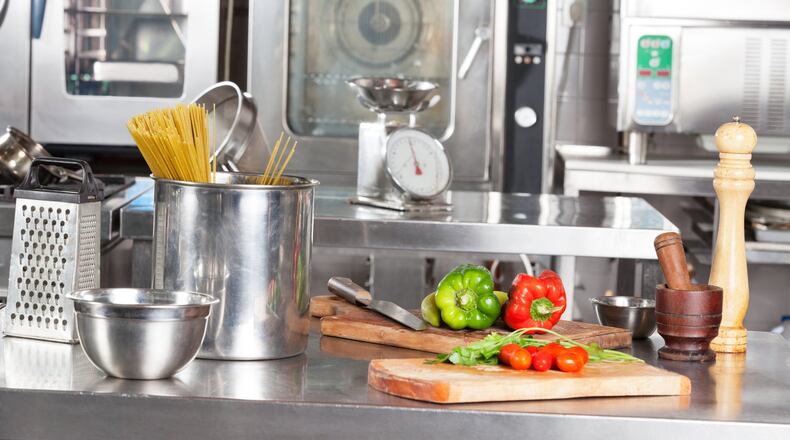Date of inspection: June 20
Violations: Observed food that was not properly protected from contamination by separation, packaging, and segregation. Carton of eggs stored on top shelf in reach in cooler over ready to eat foods. Eggs moved during inspection. Note: If you wish to keep personal food in the facility, please keep in separate, clearly labeled area of the refrigerator in a manner that prevents possible contamination. To prevent contamination, food shall be protected from cross contamination by separating raw animal foods during storage, preparation, holding, and display from cooked ready-to-eat food as described in this rule.
Observed a direct connection between the sewage system and a drain originating from equipment in which food, portable equipment, or utensils are placed. Food prep sink has an air break, not an air gap as required. To prevent health hazards, a direct connection may not exist between the sewage system and a drain originating from equipment in which food, portable equipment, or utensils are placed unless allowed by the Ohio building code for: a warewashing machine between its waste outlet and a floor drain when the machine is located within five feet (1.5 meters) of a trapped floor drain and the machine outlet is connected to the inlet side of a properly vented floor drain trap; or a warewashing and culinary sink. Correct By: 11-Jul-2017
Observed improper storage of poisonous or toxic materials. Observed chemical stored on top shelf above food in dry storage area. Observed cleaning wipes in container stored next to single-use food contact items (plastic wrap). These items were moved during inspection. To prevent contamination, poisonous or toxic materials shall be stored so they cannot contaminate food, equipment, utensils, linens, or single-service or single-use articles by: 1) Separating the poisonous materials by spacing or partitioning; and 2) Locating the poisonous or toxic materials in an area that is not above food, equipment, utensils, linens, single-service articles or single-use articles.
Facility did not have one employee with supervisory and management responsibility and the authority to direct and control food preparation and service with level two certification in food protection. Information regarding level 2 training provided during inspection. At least one employee that has supervisory and management responsibility and the authority to direct and control food preparation and service shall obtain the level two certification in food protection according to rule 3701-21-25 of the Administrative Code.
Person-in-charge did not ensure that the facility has written procedures for employees to follow when responding to vomiting or diarrheal events. Sample provided. Person in charge shall ensure that the FSO or RFE have written procedures for employees to follow when responding to vomiting or diarrheal events that involved discharge onto surfaces.
Food thermometers are not accurate to plus or minus one degree C, or plus or minus two degrees F in the intended range of use. Thermometer in kitchen not calibrated, off by approximately 20 degrees. Recommend purchasing an easily-calibratable thermometer. Also, a thermocouple must be available if thin foods are prepared. To prevent foodborne illness, food temperature measuring devices that are scaled only in Celsius or dually scaled in Fahrenheit and Celsius shall be accurate to plus or minus one degree Celsius in the intended range of use; Food temperature measuring devices that are scaled only in Fahrenheit shall be accurate to plus or minus two degrees Fahrenheit in the intended range of use.
Observed accumulation of soil residue on nonfood-contact surfaces. Handles of griddle stored in cabinet had accumulation of dried food residue. Griddle was damaged and discarded. Nonfood-contact surfaces of equipment shall be cleaned at a frequency necessary to preclude accumulation of soil residues.
Cleaned equipment and utensils, laundered linens, or single-service and single-use articles are not properly stored. Box of single-use cups stored on floor in back storage area. Recommend installing additional shelving or mechanism to keep food and single-use items off of the floor. Cleaned equipment and utensils, laundered linens, single-service articles, and single-use articles shall be properly stored as described in this rule.
Observed a build-up of dirt and debris. Areas of the floor, specifically around and under cabinets and equipment in need of more frequent cleaning. The physical facilities shall be cleaned as often as necessary to keep them clean, and cleaning shall be done during periods when the least amount of food is exposed.
Observed unnecessary or nonfunctional items and /or litter on the premises. Unused equipment (crock pots, griddles, cutting boards pans) stored in kitchen. If items are not being used, they should be removed from kitchen to facilitate cleaning. The premises shall be free of Items that are unnecessary to the operation or maintenance of the FSO or RFE such as equipment that is nonfunctional or no longer used and litter.
Comments: Temperatures within required ranges.
Information regarding level 2 certification as well as policies listed above attached to inspection report.
Note: A reinspection will be conducted to ensure the above have been corrected.
About the Author

